Jianwu Wang
B-TGAT: A Bi-directional Temporal Graph Attention Transformer for Clustering Multivariate Spatiotemporal Data
Sep 16, 2025Abstract:Clustering high-dimensional multivariate spatiotemporal climate data is challenging due to complex temporal dependencies, evolving spatial interactions, and non-stationary dynamics. Conventional clustering methods, including recurrent and convolutional models, often struggle to capture both local and global temporal relationships while preserving spatial context. We present a time-distributed hybrid U-Net autoencoder that integrates a Bi-directional Temporal Graph Attention Transformer (B-TGAT) to guide efficient temporal clustering of multidimensional spatiotemporal climate datasets. The encoder and decoder are equipped with ConvLSTM2D modules that extract joint spatial--temporal features by modeling localized dynamics and spatial correlations over time, and skip connections that preserve multiscale spatial details during feature compression and reconstruction. At the bottleneck, B-TGAT integrates graph-based spatial modeling with attention-driven temporal encoding, enabling adaptive weighting of temporal neighbors and capturing both short and long-range dependencies across regions. This architecture produces discriminative latent embeddings optimized for clustering. Experiments on three distinct spatiotemporal climate datasets demonstrate superior cluster separability, temporal stability, and alignment with known climate transitions compared to state-of-the-art baselines. The integration of ConvLSTM2D, U-Net skip connections, and B-TGAT enhances temporal clustering performance while providing interpretable insights into complex spatiotemporal variability, advancing both methodological development and climate science applications.
Improving Greenland Bed Topography Mapping with Uncertainty-Aware Graph Learning on Sparse Radar Data
Sep 10, 2025Abstract:Accurate maps of Greenland's subglacial bed are essential for sea-level projections, but radar observations are sparse and uneven. We introduce GraphTopoNet, a graph-learning framework that fuses heterogeneous supervision and explicitly models uncertainty via Monte Carlo dropout. Spatial graphs built from surface observables (elevation, velocity, mass balance) are augmented with gradient features and polynomial trends to capture both local variability and broad structure. To handle data gaps, we employ a hybrid loss that combines confidence-weighted radar supervision with dynamically balanced regularization. Applied to three Greenland subregions, GraphTopoNet outperforms interpolation, convolutional, and graph-based baselines, reducing error by up to 60 percent while preserving fine-scale glacial features. The resulting bed maps improve reliability for operational modeling, supporting agencies engaged in climate forecasting and policy. More broadly, GraphTopoNet shows how graph machine learning can convert sparse, uncertain geophysical observations into actionable knowledge at continental scale.
Cloud Optical Thickness Retrievals Using Angle Invariant Attention Based Deep Learning Models
May 30, 2025Abstract:Cloud Optical Thickness (COT) is a critical cloud property influencing Earth's climate, weather, and radiation budget. Satellite radiance measurements enable global COT retrieval, but challenges like 3D cloud effects, viewing angles, and atmospheric interference must be addressed to ensure accurate estimation. Traditionally, the Independent Pixel Approximation (IPA) method, which treats individual pixels independently, has been used for COT estimation. However, IPA introduces significant bias due to its simplified assumptions. Recently, deep learning-based models have shown improved performance over IPA but lack robustness, as they are sensitive to variations in radiance intensity, distortions, and cloud shadows. These models also introduce substantial errors in COT estimation under different solar and viewing zenith angles. To address these challenges, we propose a novel angle-invariant, attention-based deep model called Cloud-Attention-Net with Angle Coding (CAAC). Our model leverages attention mechanisms and angle embeddings to account for satellite viewing geometry and 3D radiative transfer effects, enabling more accurate retrieval of COT. Additionally, our multi-angle training strategy ensures angle invariance. Through comprehensive experiments, we demonstrate that CAAC significantly outperforms existing state-of-the-art deep learning models, reducing cloud property retrieval errors by at least a factor of nine.
DeepTopoNet: A Framework for Subglacial Topography Estimation on the Greenland Ice Sheets
May 29, 2025Abstract:Understanding Greenland's subglacial topography is critical for projecting the future mass loss of the ice sheet and its contribution to global sea-level rise. However, the complex and sparse nature of observational data, particularly information about the bed topography under the ice sheet, significantly increases the uncertainty in model projections. Bed topography is traditionally measured by airborne ice-penetrating radar that measures the ice thickness directly underneath the aircraft, leaving data gap of tens of kilometers in between flight lines. This study introduces a deep learning framework, which we call as DeepTopoNet, that integrates radar-derived ice thickness observations and BedMachine Greenland data through a novel dynamic loss-balancing mechanism. Among all efforts to reconstruct bed topography, BedMachine has emerged as one of the most widely used datasets, combining mass conservation principles and ice thickness measurements to generate high-resolution bed elevation estimates. The proposed loss function adaptively adjusts the weighting between radar and BedMachine data, ensuring robustness in areas with limited radar coverage while leveraging the high spatial resolution of BedMachine predictions i.e. bed estimates. Our approach incorporates gradient-based and trend surface features to enhance model performance and utilizes a CNN architecture designed for subgrid-scale predictions. By systematically testing on the Upernavik Isstr{\o}m) region, the model achieves high accuracy, outperforming baseline methods in reconstructing subglacial terrain. This work demonstrates the potential of deep learning in bridging observational gaps, providing a scalable and efficient solution to inferring subglacial topography.
BACON: A fully explainable AI model with graded logic for decision making problems
May 20, 2025Abstract:As machine learning models and autonomous agents are increasingly deployed in high-stakes, real-world domains such as healthcare, security, finance, and robotics, the need for transparent and trustworthy explanations has become critical. To ensure end-to-end transparency of AI decisions, we need models that are not only accurate but also fully explainable and human-tunable. We introduce BACON, a novel framework for automatically training explainable AI models for decision making problems using graded logic. BACON achieves high predictive accuracy while offering full structural transparency and precise, logic-based symbolic explanations, enabling effective human-AI collaboration and expert-guided refinement. We evaluate BACON with a diverse set of scenarios: classic Boolean approximation, Iris flower classification, house purchasing decisions and breast cancer diagnosis. In each case, BACON provides high-performance models while producing compact, human-verifiable decision logic. These results demonstrate BACON's potential as a practical and principled approach for delivering crisp, trustworthy explainable AI.
Enhancing Satellite Object Localization with Dilated Convolutions and Attention-aided Spatial Pooling
May 08, 2025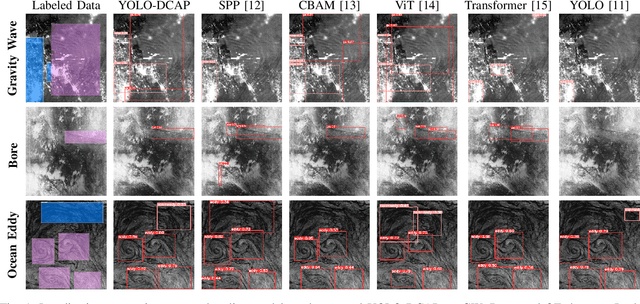
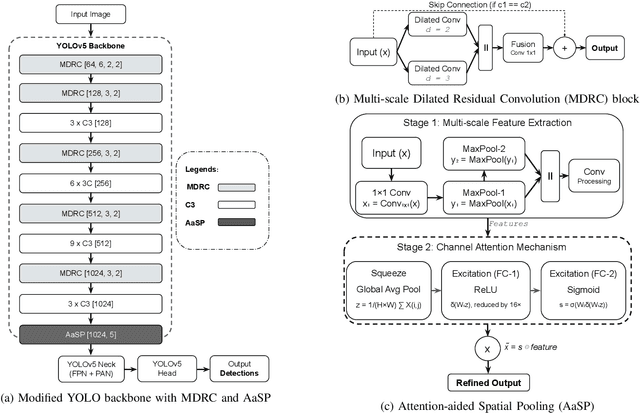
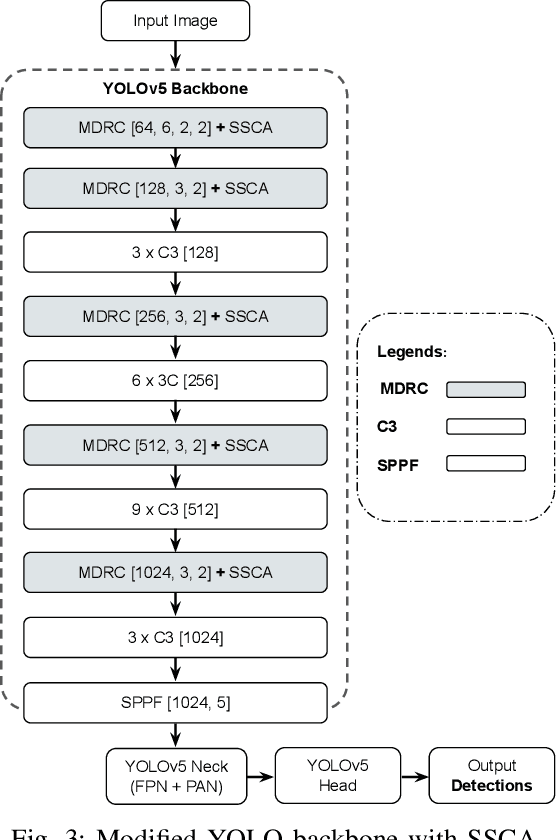

Abstract:Object localization in satellite imagery is particularly challenging due to the high variability of objects, low spatial resolution, and interference from noise and dominant features such as clouds and city lights. In this research, we focus on three satellite datasets: upper atmospheric Gravity Waves (GW), mesospheric Bores (Bore), and Ocean Eddies (OE), each presenting its own unique challenges. These challenges include the variability in the scale and appearance of the main object patterns, where the size, shape, and feature extent of objects of interest can differ significantly. To address these challenges, we introduce YOLO-DCAP, a novel enhanced version of YOLOv5 designed to improve object localization in these complex scenarios. YOLO-DCAP incorporates a Multi-scale Dilated Residual Convolution (MDRC) block to capture multi-scale features at scale with varying dilation rates, and an Attention-aided Spatial Pooling (AaSP) module to focus on the global relevant spatial regions, enhancing feature selection. These structural improvements help to better localize objects in satellite imagery. Experimental results demonstrate that YOLO-DCAP significantly outperforms both the YOLO base model and state-of-the-art approaches, achieving an average improvement of 20.95% in mAP50 and 32.23% in IoU over the base model, and 7.35% and 9.84% respectively over state-of-the-art alternatives, consistently across all three satellite datasets. These consistent gains across all three satellite datasets highlight the robustness and generalizability of the proposed approach. Our code is open sourced at https://github.com/AI-4-atmosphere-remote-sensing/satellite-object-localization.
Joint Retrieval of Cloud properties using Attention-based Deep Learning Models
Apr 09, 2025



Abstract:Accurate cloud property retrieval is vital for understanding cloud behavior and its impact on climate, including applications in weather forecasting, climate modeling, and estimating Earth's radiation balance. The Independent Pixel Approximation (IPA), a widely used physics-based approach, simplifies radiative transfer calculations by assuming each pixel is independent of its neighbors. While computationally efficient, IPA has significant limitations, such as inaccuracies from 3D radiative effects, errors at cloud edges, and ineffectiveness for overlapping or heterogeneous cloud fields. Recent AI/ML-based deep learning models have improved retrieval accuracy by leveraging spatial relationships across pixels. However, these models are often memory-intensive, retrieve only a single cloud property, or struggle with joint property retrievals. To overcome these challenges, we introduce CloudUNet with Attention Module (CAM), a compact UNet-based model that employs attention mechanisms to reduce errors in thick, overlapping cloud regions and a specialized loss function for joint retrieval of Cloud Optical Thickness (COT) and Cloud Effective Radius (CER). Experiments on a Large Eddy Simulation (LES) dataset show that our CAM model outperforms state-of-the-art deep learning methods, reducing mean absolute errors (MAE) by 34% for COT and 42% for CER, and achieving 76% and 86% lower MAE for COT and CER retrievals compared to the IPA method.
Integrating Frequency-Domain Representations with Low-Rank Adaptation in Vision-Language Models
Mar 08, 2025



Abstract:Situational awareness applications rely heavily on real-time processing of visual and textual data to provide actionable insights. Vision language models (VLMs) have become essential tools for interpreting complex environments by connecting visual inputs with natural language descriptions. However, these models often face computational challenges, especially when required to perform efficiently in real environments. This research presents a novel vision language model (VLM) framework that leverages frequency domain transformations and low-rank adaptation (LoRA) to enhance feature extraction, scalability, and efficiency. Unlike traditional VLMs, which rely solely on spatial-domain representations, our approach incorporates Discrete Fourier Transform (DFT) based low-rank features while retaining pretrained spatial weights, enabling robust performance in noisy or low visibility scenarios. We evaluated the proposed model on caption generation and Visual Question Answering (VQA) tasks using benchmark datasets with varying levels of Gaussian noise. Quantitative results demonstrate that our model achieves evaluation metrics comparable to state-of-the-art VLMs, such as CLIP ViT-L/14 and SigLIP. Qualitative analysis further reveals that our model provides more detailed and contextually relevant responses, particularly for real-world images captured by a RealSense camera mounted on an Unmanned Ground Vehicle (UGV).
Correlation to Causation: A Causal Deep Learning Framework for Arctic Sea Ice Prediction
Mar 03, 2025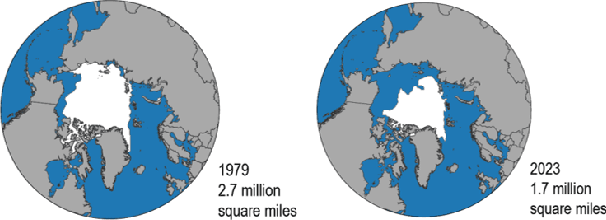
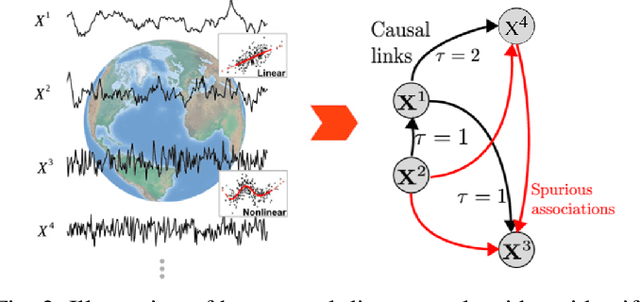

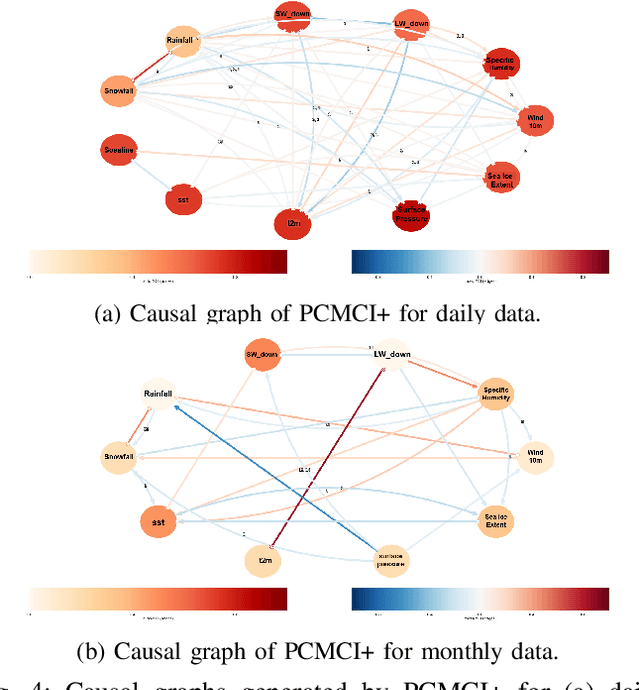
Abstract:Traditional machine learning and deep learning techniques rely on correlation-based learning, often failing to distinguish spurious associations from true causal relationships, which limits robustness, interpretability, and generalizability. To address these challenges, we propose a causality-driven deep learning framework that integrates Multivariate Granger Causality (MVGC) and PCMCI+ causal discovery algorithms with a hybrid deep learning architecture. Using 43 years (1979-2021) of daily and monthly Arctic Sea Ice Extent (SIE) and ocean-atmospheric datasets, our approach identifies causally significant factors, prioritizes features with direct influence, reduces feature overhead, and improves computational efficiency. Experiments demonstrate that integrating causal features enhances the deep learning model's predictive accuracy and interpretability across multiple lead times. Beyond SIE prediction, the proposed framework offers a scalable solution for dynamic, high-dimensional systems, advancing both theoretical understanding and practical applications in predictive modeling.
Building Machine Learning Challenges for Anomaly Detection in Science
Mar 03, 2025Abstract:Scientific discoveries are often made by finding a pattern or object that was not predicted by the known rules of science. Oftentimes, these anomalous events or objects that do not conform to the norms are an indication that the rules of science governing the data are incomplete, and something new needs to be present to explain these unexpected outliers. The challenge of finding anomalies can be confounding since it requires codifying a complete knowledge of the known scientific behaviors and then projecting these known behaviors on the data to look for deviations. When utilizing machine learning, this presents a particular challenge since we require that the model not only understands scientific data perfectly but also recognizes when the data is inconsistent and out of the scope of its trained behavior. In this paper, we present three datasets aimed at developing machine learning-based anomaly detection for disparate scientific domains covering astrophysics, genomics, and polar science. We present the different datasets along with a scheme to make machine learning challenges around the three datasets findable, accessible, interoperable, and reusable (FAIR). Furthermore, we present an approach that generalizes to future machine learning challenges, enabling the possibility of large, more compute-intensive challenges that can ultimately lead to scientific discovery.
 Add to Chrome
Add to Chrome Add to Firefox
Add to Firefox Add to Edge
Add to Edge